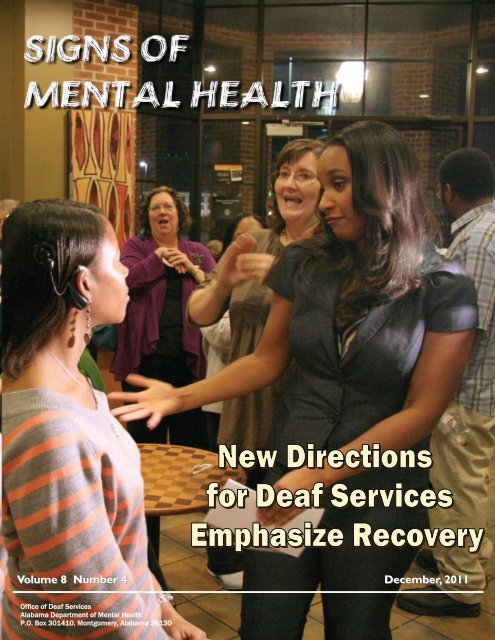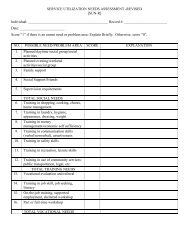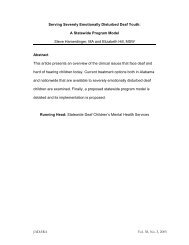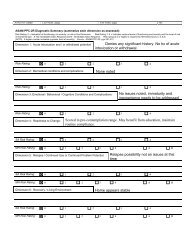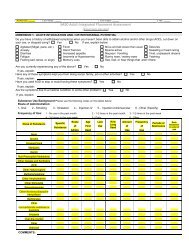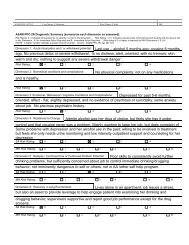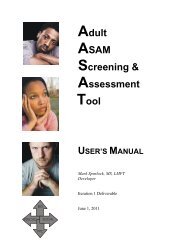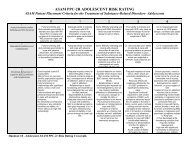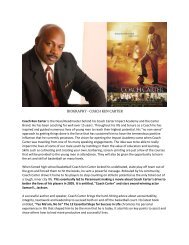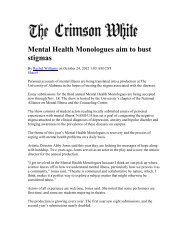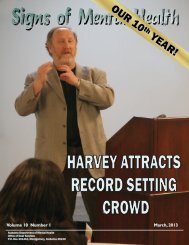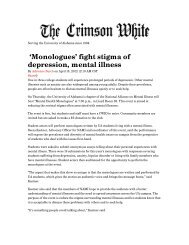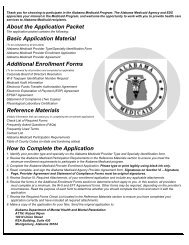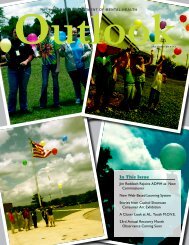Volume 8 Number 4 December, 2011 - Alabama Department of ...
Volume 8 Number 4 December, 2011 - Alabama Department of ...
Volume 8 Number 4 December, 2011 - Alabama Department of ...
Create successful ePaper yourself
Turn your PDF publications into a flip-book with our unique Google optimized e-Paper software.
<strong>Volume</strong> 8 <strong>Number</strong> 4 <strong>December</strong>, <strong>2011</strong><br />
Office <strong>of</strong> Deaf Services<br />
<strong>Alabama</strong> <strong>Department</strong> <strong>of</strong> Mental Health<br />
P.O. Box 301410, Montgomery, <strong>Alabama</strong> 36130
IN THIS ISSUE<br />
MHIT Increases Online<br />
Presence 2<br />
Lonnie Wright Becomes First<br />
Deaf Peer Support Specialist 3<br />
New Year Brings Big Changes<br />
in Deaf Services 4<br />
C<strong>of</strong>fee Night Tradition Continues,<br />
Draws Media Attention 5<br />
As I See It 6<br />
SERID Conference A Hit In<br />
<strong>Alabama</strong> 7<br />
Japanese Deaf LCSW Visits<br />
ODS, <strong>Alabama</strong> 8<br />
Working with People who<br />
have Deaf-Blindness 8<br />
On the ODS Bookshelf 10<br />
Qualified Mental Health<br />
Interpreters 11<br />
Call for Presentations: Breakout<br />
Conference 14<br />
New Educational Initiative<br />
Proves Popular and Effective 16<br />
MHIT 2012 Announced 18<br />
The Office <strong>of</strong> Deaf Services has had an eventful Fall! Between<br />
a total reordering <strong>of</strong> how Deaf Services will be done<br />
in <strong>Alabama</strong> to a number <strong>of</strong> personal milestones for several ODS staff members, we<br />
have a lot to keep our hands flapping around the water cooler. That also means there<br />
is a lot <strong>of</strong> news in this particular issue <strong>of</strong> the newsletter.<br />
Three years ago the cover story in SOMH was “Deaf C<strong>of</strong>fee Night” and how it has<br />
changed the local deaf community. This month, as it happened, the local media in<br />
Montgomery decided to spotlight this monthly activity, so that story becomes the cover<br />
<strong>of</strong> this one as well.<br />
We are thrilled to see Lonnie Wright become the first deaf person certified as a<br />
peer-support specialist. The first <strong>of</strong> many, we hope. That story begins on page 3.<br />
Oh that restructure mentioned above Read about it beginning on page 4. This will be<br />
the first <strong>of</strong> many stories about the change from hospital-based services to community<br />
based services.<br />
While you are at it, check out personal achievements by Sereta Campbell (page 7),<br />
Wendy Darling (page 12), and Charlene Crump (page 16) . We are proud <strong>of</strong> them. <br />
MHIT Increases Online Presence<br />
ADARA and the Office <strong>of</strong> Deaf<br />
Services recently announced that<br />
their renowned Mental Health<br />
Interpreter Training program partnership<br />
has a new online social<br />
media presence in the form <strong>of</strong> a<br />
Facebook page.<br />
Facebook is one <strong>of</strong> the most<br />
popular social media outlets in the<br />
world. While MHIT has had a<br />
website for years, it was not until<br />
this month that a venture into<br />
social media was attempted.<br />
Signs <strong>of</strong> Mental Health<br />
ADMH, Office <strong>of</strong> Deaf Services<br />
Zelia Baugh, Commissioner<br />
Steve Hamerdinger, Director<br />
P.O. Box 310410<br />
Montgomery, AL 36130<br />
steve.hamerdinger@mh.alabama.gov<br />
On The Cover:<br />
WAKA television personality, Tamika<br />
Bickham (right) talks with Nicole Lamont at<br />
Deaf C<strong>of</strong>fee Night. Charlene Crump<br />
interprets. See story on Page X<br />
“I wouldn’t call it ‘viral’ yet, but there have been quite <strong>of</strong> few people who have liked the<br />
site and it is making the rounds,” said ODS Director, Steve Hamerdinger.<br />
The page includes pictures <strong>of</strong> all the MHIT classes. It will also provide a venue for<br />
announcing important information, not only about the training events <strong>of</strong>fered, but also<br />
about changes happening in ODS and the field <strong>of</strong> interpreting in general. Job<br />
announcements will be posted. It will be a place where videos can be posted as well.<br />
You can view the page at http://www.facebook.com/pages/Mental-Health-Interpreter-<br />
Training-MHIT/354463064568951, or as they say on Facebook, “Like Us!”
Lonnie Wright Becomes First<br />
<strong>Alabama</strong> Certified Deaf<br />
Peer Support Specialist<br />
DEAF SERVICES<br />
REGIONAL OFFICES<br />
Region 1<br />
Ben Hollingsworth, Therapist<br />
Dawn Vanzo, Interpreter<br />
Mental Health Center <strong>of</strong><br />
Madison County<br />
4040 South Memorial Pkwy<br />
Huntsville, AL 35802<br />
(256) 533-1970 (Voice)<br />
(256) 533-1922 (TTY)<br />
Region 2<br />
Therapist, Vacant<br />
Sereta Campbell, Interpreter<br />
Bryce Psychiatric Hospital<br />
200 University Boulevard<br />
Tuscaloosa, AL 35401<br />
(205) 759-0698 (Voice)<br />
(205) 759-0890 (FAX)<br />
On hand to congratulate Lonnie Wright (center) were (left to right): Steve Hamerdinger, Office <strong>of</strong> Deaf Services; Mike<br />
Autrey, Director, Office <strong>of</strong> Consumer Relations; Stacey Grey, JBS Deaf Services Social Worker; Tessie Crum, JBS<br />
Group Home Manager, Malissa Gallagher, JBS Deaf Services Program Manager.<br />
When Lonnie Wright was presented with his<br />
certificate as a Peer Support Specialist<br />
Friday, 13 January, he joined a very select<br />
group <strong>of</strong> people. Not just the select group <strong>of</strong><br />
Peer Support Specialists, but an even more<br />
exclusive group – Deaf Alabamians who have<br />
made historic breakthroughs.<br />
Wright, who has been involved with the Deaf<br />
Services program at JBS Mental Health<br />
Authority in Birmingham, became the first<br />
deaf person to become a certified peer<br />
support specialist in <strong>Alabama</strong>, joining a<br />
relatively small group <strong>of</strong> deaf people nationwide<br />
who have achieved the same status.<br />
“Lonnie was a leader during training,<br />
encouraging other consumers, leading study<br />
groups and being involved,” said Mike Autrey,<br />
Director <strong>of</strong> the Office <strong>of</strong> Consumer Relations<br />
as he presented the award.<br />
“I wanted to help other deaf people. I think<br />
it’s my responsibility,” Wright told the Signs<br />
<strong>of</strong> Mental Health. Certified Peer Specialists<br />
promote recovery by sharing their personal<br />
experiences with mental illness and personal<br />
recovery experiences, helping consumers<br />
understand mental illness. They assist<br />
consumers in identifying barriers to recovery<br />
and help consumers identify individual warning<br />
signs. Certified Peer Specialists also assist<br />
consumers to develop communication<br />
and social skills, problem solving skills, skills<br />
in combating negative self-talk, self-help<br />
skills, and in developing support systems.<br />
Other deaf consumers are planning to follow<br />
his path. There is at least one deaf person<br />
enrolled in the next Peer Support training,<br />
schedule to take place later in January. The<br />
<strong>Alabama</strong> training is a five-day program that<br />
includes instruction, discussion and role play<br />
with an examination after the training. Peer<br />
specialists are hired by individual providers<br />
and are subject to the provider’s application<br />
(Continued on page 16)<br />
Region 3<br />
Scott Staubach, Therapist<br />
Wendy Darling, Interpreter<br />
Montgomery Area<br />
Mental Health Authority<br />
101 Coliseum Boulevard<br />
Montgomery, AL 36109<br />
(334) 279-7830 (Voice)<br />
(334) 271-2855 (TTY)<br />
Region 4<br />
Therapist, Vacant<br />
Lee Stoutamire, Interpreter<br />
AltaPointe Health Systems<br />
501 Bishop Lane N.<br />
Mobile, AL 36608<br />
(251) 450-4353 (Voice)<br />
(251) 450-4371 (TTY)
New Year Brings Big Changes<br />
in Deaf Services<br />
There are big changes in services to Deaf Alabamians with<br />
mental illness coming in 2012. These changes were<br />
announced by Deaf Services Director Steve Hamerdinger at<br />
the Office <strong>of</strong> Deaf Services Advisory Group meeting in Montgomery<br />
<strong>Alabama</strong> on November 17, <strong>2011</strong>.<br />
For a long time there has been a steady shrinking in linguistically<br />
appropriate services to deaf people. At one time there<br />
were four regional <strong>of</strong>fices, each with a counselor. By the<br />
beginning <strong>of</strong> <strong>2011</strong>, there was only one deaf therapist left.<br />
There were, at one time, as many as 15 slots in community<br />
residential programs serving deaf people specifically. Today,<br />
there are only nine.<br />
One devastating impact <strong>of</strong> this steady downsizing was felt at<br />
the Bailey Deaf Unit. Before, it was a program that was led by<br />
deaf people, staffed by deaf people, where deaf people<br />
received services that were “Deaf-friendly.” Over time, many<br />
<strong>of</strong> the deaf pr<strong>of</strong>essional level positions in the program were<br />
lost to “downsizing.”<br />
Worse than that, people who had mental illness and were<br />
admitted to BDU increasingly found themselves with no place<br />
to go when they were ready to leave. The loss <strong>of</strong> services in<br />
the community meant that deaf people increasingly were<br />
“stuck” in a program that was never meant to be long term.<br />
BDU was becoming more and more “hearing” at the same<br />
time deaf people were staying longer and longer.<br />
<strong>Department</strong> <strong>of</strong> Mental Health Commissioner Zelia Baugh and<br />
Associate Commissioner for Mental Health and Substance<br />
Abuse, Tammy Peacock, wanted to change this trend. Dr.<br />
Peacock asked Hamerdinger, “What would it take to make<br />
things better” From that initial discussion a new plan was<br />
developed.<br />
The new plan, which is loosely based on the transformation<br />
<strong>of</strong> services that happened in South Carolina over the past<br />
decade, will shift focus from in-patient services, which is a<br />
medical model, to community services focusing on recovery,<br />
and is more “person-centered.”<br />
The Bailey Deaf Unit is scheduled to cease operation in Montgomery<br />
in the spring, and new programs will open around the<br />
state to take its place Hamerdinger announced.<br />
A six-bed Deaf Recovery Program will open in Tuscaloosa,<br />
where deaf people who have been in the hospital will be able<br />
to work on skills they need to succeed in the community. The<br />
new program will be located on property <strong>of</strong> the old Partlow<br />
Developmental Center, which is now closed. There are a<br />
number <strong>of</strong> cottages on the property which are easily<br />
adaptable to the needs <strong>of</strong> the program. In addition, the DRP,<br />
slated to be housed in Cottage 9, will be a stone’s throw from<br />
the new psychiatric hospital that will replace Bryce and is<br />
now under construction.<br />
(Continued on page 12)
C<strong>of</strong>fee Night Tradition Continues, Draws Media Attention<br />
For nearly five years, monthly “Deaf C<strong>of</strong>fee Nights” have<br />
provided opportunities for deaf and signing individuals to<br />
share time and information together as a community. The<br />
tradition will carry on in 2012 as deaf individuals and<br />
students, interpreters, signers, family members, and others<br />
gather at the Starbucks on the Eastern Boulevard in<br />
Montgomery.<br />
Left: Tamika Bickham talks with Troy Interpreter Training Program Student<br />
Aley Konesky. Above: This picture was published in the Winter 2009 issue <strong>of</strong><br />
the Signs <strong>of</strong> Mental Health. Right to Left: Nicole Lamont, Johnny Sears, and<br />
Courtney Tarver. Nicole is featured on our cover this issue<br />
In March 2007, the <strong>Alabama</strong> <strong>Department</strong> <strong>of</strong> Mental Health’s<br />
Office <strong>of</strong> Deaf Services staff lamented the lack <strong>of</strong> community<br />
activities that would help draw deaf people together. The first<br />
Deaf C<strong>of</strong>fee Night grew from those discussions. It drew about<br />
a dozen attendees. Since then, what started as a small<br />
project has grown into a series <strong>of</strong> opportunities for deaf<br />
people from all walks <strong>of</strong> life to come together and connect.<br />
The events have also fueled a resurgence <strong>of</strong> activity for the<br />
local association <strong>of</strong> the deaf. C<strong>of</strong>fee night is now drawing 30<br />
to 70 attendees and is co-sponsored by the Montgomery<br />
Chapter <strong>of</strong> the <strong>Alabama</strong> Association <strong>of</strong> the Deaf.<br />
The Signs <strong>of</strong> Mental Health published a feature<br />
about Deaf C<strong>of</strong>fee Night in its Winter, 2009 issue.<br />
At the most recent event, held on January 6,<br />
reporters from two local television stations joined<br />
the crowd <strong>of</strong> about 60 people. Several people<br />
were interviewed, including Nicole<br />
Lamont, who was pictured in the original 2009<br />
story. "It's important for the deaf community<br />
because we need our group, someplace we<br />
can feel safe and have a group <strong>of</strong> friends we<br />
can just hang out with. It's important for the<br />
public to learn more about us," said<br />
Lamont.<br />
Cover <strong>of</strong> the Winter, 2009 issue which featured<br />
Deaf C<strong>of</strong>fee Night. Since that time other similar<br />
events have opened in Huntsville, Birmingham<br />
and Mobile<br />
Deaf group home residents and the occasional curious<br />
nonsigning hearing individuals also can be found at<br />
Starbucks on the first Friday <strong>of</strong> each month. The store has<br />
come to expect them and even keeps paper and pen on hand<br />
for orders.<br />
ADMH’s Office <strong>of</strong> Deaf Services has long understood the<br />
need to have a highly visible presence among the deaf<br />
community. These c<strong>of</strong>fee nights provide deaf individuals an<br />
opportunity for a language-accessible social outlet, the Office<br />
<strong>of</strong> Deaf Services another venue to educate and an<br />
opportunity for signers to hone their skills. Because ODS is<br />
part <strong>of</strong> the <strong>Alabama</strong> <strong>Department</strong> <strong>of</strong> Mental Health’s Division<br />
<strong>of</strong> Mental Health & Substance Abuse Services, the events<br />
also help promote better understanding <strong>of</strong> mental<br />
illnesses and the role <strong>of</strong> mental health services.<br />
Finally, and perhaps most importantly to ODS staff,<br />
Deaf C<strong>of</strong>fee Nights serve to raise awareness<br />
that there is a population <strong>of</strong><br />
deaf people who are fully functioning<br />
members <strong>of</strong> their community. ODS<br />
state coordinator Charlene Crump, who<br />
helped start the initiative, says, “To me,<br />
it’s a monthly family reunion, where we<br />
regularly meet new family members and<br />
share c<strong>of</strong>fee, information and memories.<br />
It’s been wonderful to see it continue and<br />
grow over the years.” <br />
5 <strong>Volume</strong> 8 <strong>Number</strong> 4
programs. We had consumers trapped on the in-patient unit<br />
with no good options for getting them out except to return<br />
them to the same, inaccessible, inappropriate and <strong>of</strong>ten<br />
neglectful places from whence they came. We were losing<br />
residential options in the community. We were not able to<br />
replace staff lost to attrition. Deaf Services was, to be blunt,<br />
slowly dying.<br />
By the time this newsletter reaches its readers, the Office <strong>of</strong><br />
Deaf Services be well into its tenth year <strong>of</strong> operation. This is<br />
being written on one <strong>of</strong> the coldest day I can<br />
remember in that interim.<br />
Well aware that Alabamians are not renowned for their love<br />
<strong>of</strong> arctic conditions, (stop giggling, you northerners) winter, or<br />
at least the <strong>Alabama</strong> version <strong>of</strong> it, serves to remind us that<br />
there is a cycle to everything. As surely as the dog has to be<br />
chipped <strong>of</strong>f the fire hydrant following its morning ablutions<br />
today, crocus will bloom tomorrow and the azaleas soon<br />
after. (Can the Masters and Opening Day be far behind)<br />
What makes the upcoming year so exciting is the promise <strong>of</strong><br />
positive change, even amidst the cold reality <strong>of</strong> economic<br />
uncertainty. Instead <strong>of</strong><br />
contracting and dying, the<br />
<strong>Alabama</strong> <strong>Department</strong> <strong>of</strong><br />
Mental Health is positioning<br />
its Deaf Services to bloom<br />
with new directions and new<br />
opportunities.<br />
Business as usual leads to<br />
stagnation and decline,<br />
especially in today’s<br />
economic environment.<br />
State funding for mental<br />
health services will be, at<br />
best, flat for the next couple<br />
<strong>of</strong> years. Costs, unfortunately, will not be flat. “Therein,”<br />
quoth Shakespeare, “lies the rub.” Social services, especially<br />
for low-incident groups like deaf people with mental illness,<br />
are in for difficult times when a larger and larger number <strong>of</strong><br />
people are competing for pieces <strong>of</strong> a smaller and smaller pie.<br />
Despite a well-earned reputation as a cynic, nevertheless I<br />
am thinking about Harry S Truman and his view on adversity.<br />
“A pessimist is one who makes difficulties <strong>of</strong> his opportunities<br />
and an optimist is one who makes opportunities <strong>of</strong> his<br />
difficulties.” There have indeed been difficulties over the<br />
past few years. There have been times when even those who<br />
usually see only the sunny side <strong>of</strong> life were getting glum<br />
about the future <strong>of</strong> deaf services. We lost funding for<br />
Mental illness work has traditionally been built on a medical<br />
model. It can be a hard, frozen ground upon which to work.<br />
It discounts the impact <strong>of</strong> culture and language and sees<br />
“recovery” as merely compliance with a chemical regime that<br />
has little regard for the human quality <strong>of</strong> life. For deaf<br />
people, linguistic appropriateness and cultural awareness is<br />
not just a nice idea. Recovery cannot happen without them.<br />
Over the past decade, the emerging Recovery Movement has<br />
been dragging the treatment system, kicking and screaming,<br />
from the medical model to something more consumerdirected.<br />
At least that is the theory. Again, the norms that<br />
deaf people embrace as part <strong>of</strong> Deaf Culture lead them to<br />
see the world differently than hearing people. How learning<br />
takes place is different. How concepts are transmitted and<br />
internalized is different. The Recovery Model has the<br />
flexibility to allow for programs to develop within the context<br />
<strong>of</strong> the “Deaf Way.” In fact, if<br />
the mental health service<br />
s y s t e m t r u l y<br />
embraced “Recovery” it<br />
would also embrace true “For<br />
us, by us” approaches.<br />
The reality, <strong>of</strong> course, is<br />
<strong>of</strong>ten one dogma replaces<br />
another. Bureaucracy, in<br />
general, does not reward<br />
flexible thinking. When one<br />
(usually top – down)<br />
structure is forcibly dismantled,<br />
the machine insists that<br />
it be replaced with another (usually top – down) structure <strong>of</strong><br />
equal inflexibility. For example, the medical model has been<br />
supplanted by the consumer empowerment movement,<br />
which in turn has adopted its own set <strong>of</strong> inflexible “evidencebased<br />
practices,” and whatnot. Thus change from one system<br />
that forces people into little pigeonholes usually leads to<br />
another system that forces people into different pigeonholes<br />
<strong>of</strong>ten without much regard for the preferences <strong>of</strong> consumers.<br />
Especially not consumers who do not fit the pigeonholes.<br />
Alas, “Deaf Way” is not one <strong>of</strong> those pigeonholes.<br />
Once in a while, someone gets into a position to blow up the<br />
pigeonholes. That’s when true change happens and that is<br />
(Continued on page 13)
SERID Conference A Hit In <strong>Alabama</strong><br />
The 40 th annual Southeast Regional Institute on Deafness<br />
conference was held at the Renaissance Hotel October 17 –<br />
19. Bedarius Bell, the State Coordinator for Deaf Services at<br />
the <strong>Alabama</strong> <strong>Department</strong> <strong>of</strong> Vocational Services was the<br />
Conference Chair.<br />
Houston, Campbell Honored at Gala<br />
John Houston, former Commissioner for Mental Health,<br />
was honored by the Southeast Regional Institute on<br />
Deafness with the Distinguished Service Award.<br />
SERID consists <strong>of</strong> eight states in the southeast (<strong>Alabama</strong>, Florida,<br />
Georgia, Kentucky, Mississippi, North Carolina, South<br />
Carolina, and Tennessee), but the reputation <strong>of</strong> the<br />
conference extends across the country. The first conference<br />
was held in 1971. Historically each state's Rehabilitation<br />
Agency has assumed leadership by coordinating resources<br />
within the state toward planning and conducting the Institute.<br />
Some <strong>of</strong> the groups traditionally involved in the Institute<br />
include State <strong>Department</strong>s <strong>of</strong> Education, Steve Vocational<br />
Rehabilitation programs, State Residential School(s) for the<br />
Deaf and Mental Health Agencies.<br />
[John Houston] knew full well how long and hard the<br />
road to appropriate services was, and would not<br />
attempt to balance the budget on the backs <strong>of</strong> people<br />
who were the least likely to fight back. In this respect,<br />
Commissioner Houston stands out from many <strong>of</strong> his<br />
peers around the country, who under intense<br />
budgetary pressures may be tempted to look at deaf<br />
services a luxury, instead <strong>of</strong> a human right.<br />
Sereta Campbell was named Outstanding Interpreter <strong>of</strong><br />
the year at the same ceremony. Since 2008, Campbell<br />
has been the Region II interpreter. Her citation read in<br />
part:<br />
“Standing out” from the group by means <strong>of</strong> distinctive<br />
service is a characteristic <strong>of</strong> Sereta Campbell’s tenure<br />
as the Region III Interpreter for the Office <strong>of</strong> Deaf<br />
Services. Ms. Campbell stands out as an unselfish<br />
person who will go out <strong>of</strong> her way to help others. She<br />
stands out as an optimist who spreads contagious<br />
enthusiasm among her colleagues. And she stands<br />
out as pillar <strong>of</strong> support, ever ready to encourage<br />
those <strong>of</strong> use who are struggling with the<br />
vicissitudes <strong>of</strong> an exigent career. She stands out as a<br />
person who exemplifies pr<strong>of</strong>essionalism<br />
in interpreting.<br />
Dr. Deb Guthmann, internationally recognized as the expert on substance<br />
abuse in the def population, was the opening speaker at SERID.<br />
The Office <strong>of</strong> Deaf Services helped coordinate a mental health<br />
track and several staff members were among those<br />
selected to present.<br />
Dr. Deb Guthmann, an internationally renowned authority on<br />
chemical dependence among deaf people, led a plenary<br />
session entitled, “We Didn’t Learn It All in Kindergarten: What<br />
Our Experience in the Field has Taught Us’ where she<br />
discussed what is currently happening in substance abuse<br />
research, assessment and treatment . She also shared<br />
stories <strong>of</strong> deaf people in recovery.<br />
Other Plenary and Keynote presenters included Anindya<br />
Bhattachryya, a Deaf-Blind man who is the Technology<br />
Both honorees<br />
exemplify the spirit<br />
that makes<br />
<strong>Alabama</strong> a leader<br />
in mental health<br />
services for deaf<br />
people.<br />
Sereta Campbell<br />
(left) and<br />
John Houston<br />
(right)<br />
with their<br />
awards.<br />
(Continued on page 11)
Japanese Deaf LCSW Visits ODS, <strong>Alabama</strong><br />
Kota Takayama, a licensed social worker from Tokyo, Japan,<br />
visited <strong>Alabama</strong> to see first hand how mental health services<br />
are delivered to deaf people. His visit, November 1 – 5, took<br />
him to various parts <strong>of</strong> <strong>Alabama</strong> to see first hand not only<br />
how mental health services are delivered, but also other<br />
parts <strong>of</strong> the social service continuum.<br />
Hamerdinger heard several times while he was in Japan.<br />
Takayama stressed several time s the need for Japan to improve<br />
training and monitioring <strong>of</strong> interpreters working with<br />
deaf people.<br />
Since Takayama’s visit coincided with Deaf C<strong>of</strong>fee Night in<br />
Montgomery, he was the guest <strong>of</strong> honor and was talked into<br />
giving a short talk to the assembled crowd. He also lectured<br />
at a sign language class that was taught at Auburn University<br />
at Montgomery. Hamerdinger observed that “Pay backs are<br />
hell!” remembering all the various classes and assemblages<br />
he was asked to talk to while in Tokyo. “He was a good sport<br />
about it!”<br />
Takayama (left) discusses treatment approaches with Dr. Frances<br />
Ralston, who is the Deaf Services Psychologist based at the<br />
Bailey Deaf Unit.<br />
Takayama, who happens to be deaf, was one <strong>of</strong> the people<br />
who ODS Director, Steve Hamerdinger, spent considerable<br />
time with while visiting Japan last summer. Takayama spent<br />
one day visiting Birmingham to see the group homes and<br />
meet with the staff <strong>of</strong> JBS Deaf Services. He also traveled to<br />
Talladega to see E.H.Gentry Vocational School and learn how<br />
Mental Health, Vocational Rehabilitation and the <strong>Alabama</strong><br />
Institute for the Deaf and Blind work together to provide an<br />
array <strong>of</strong> programming for deaf consumers.<br />
The Mental Health Interpreter Training Program was another<br />
area that Takayama was very interested in, echoing what<br />
Working with People who<br />
have Deaf-Blindness<br />
Takayama with an ASL I class from Auburn University at<br />
Montgomery. Charlene Crump is the instructor <strong>of</strong> the class.<br />
No visit to <strong>Alabama</strong> would be complete without a stop at a<br />
local Chik-fil-A. While many American fast food chains have a<br />
presence in Japan, Chik-fil-A does not. Takayama was<br />
impressed with the taste. “I want this food to come Japan,<br />
it’s delicious. Very different from what we have in Japan,” he<br />
said.<br />
American—style sushi Not so much. <br />
By Wendy Darling<br />
I’ve always had a pr<strong>of</strong>essional and personal interest in serving<br />
consumers who are Deaf, hence the job title; but from the<br />
moment I first met a person who is Deaf-blind in 1999, I’ve<br />
been captivated with tactile interpreting and the Deaf-Blind<br />
community. Unfortunately I had little opportunity to meet<br />
other people who were Deaf-Blind until I worked as a Support<br />
Service Provider (SSP) at Deaf Way II in Washington, D.C. in<br />
2002. That was such a wonderful opportunity; talk about full<br />
immersion! If I wasn’t head over heels before Deaf Way II, I<br />
(Continued on page 9)<br />
Wendy Darling (right) interprets questions from the audience for SERID keynote<br />
speaker Anindya “Bapin” Bhattacharyya, who is Deaf-Blind and has traveled<br />
the work advocating for access to services.
Working with People who have Deaf-<br />
Blindness<br />
(Continued from page 8)<br />
certainly was after that week. Again, back at home, I had<br />
little opportunity to pursue my rejuvenated interest. Thankfully,<br />
I now have the opportunity and training to interact and<br />
work with a variety <strong>of</strong> consumers and friends who are<br />
Deaf-Blind. This year I completed coursework for a Certificate<br />
<strong>of</strong> Deaf-Blind Rehabilitation from Northern Illinois University,<br />
participated in a mentoring project for Interpreters for Deaf-<br />
Blind consumers sponsored by Gallaudet University, attended<br />
the <strong>2011</strong> American Association for the Deaf-Blind (AADB)<br />
Symposium in Kentucky as an Interpreter, and coordinated<br />
Interpreters and SSPs for the attendees and keynote speakers<br />
who are Deaf-Blind at the Southeastern Regional Institute<br />
<strong>of</strong> Deafness (SERID) conference in October. Although that<br />
sounds like a lot, and it has<br />
been a busy year, I have so<br />
much more to learn. Let me<br />
tell you about my year…<br />
At the end <strong>of</strong> 2010, I applied<br />
to Northern Illinois University<br />
to enter a program there <strong>of</strong>fering<br />
a Certificate in Deaf-Blind<br />
Rehabilitation. I was accepted<br />
and began the New Year<br />
learning about all aspects <strong>of</strong><br />
Deaf-blindness: the etiologies<br />
<strong>of</strong> Deaf-blindness, communication<br />
needs, human guiding,<br />
psychosocial aspects, personal<br />
futures planning, and<br />
more. As part <strong>of</strong> the program I traveled to the Helen Keller<br />
National Center (HKNC) in Sands Point, New York for a week<br />
<strong>of</strong> hands-on training (hands-on, get it). While at the HKNC I<br />
met colleagues from across the United States. I learned so<br />
much from their experiences. I also worked as an SSP for<br />
several outings that week. After returning to <strong>Alabama</strong> I continued<br />
with the on-line portion <strong>of</strong> the course. At the end, I<br />
turned in my project and now await my Certificate (suitable<br />
for framing).<br />
I first heard <strong>of</strong> the AADB Symposium through a colleague. I<br />
knew immediately that I wanted to attend, but how As a<br />
member <strong>of</strong> AADB, I got an email advertising the Mentorship<br />
Project for Deaf-Blind Interpreters through Gallaudet University.<br />
I wasted no time sending in my application. I was accepted,<br />
completed the coursework, and traveled to KY for the<br />
AADB Symposium. I arrived on a Sunday afternoon and was<br />
soon put to work. I was assigned a team member and dele-<br />
gate and was pushed out <strong>of</strong> the nest. Thankfully, I only lost a<br />
few feathers in my furious attempt to fly.<br />
The delegate I worked with for most <strong>of</strong> the week was from<br />
New Orleans, born blind and had Meniere’s disease. As she<br />
grew up, she gradually lost her hearing but did not learn sign<br />
language until she became totally deaf in 2004. With that<br />
information, I considered the adjustments and adaptations I<br />
would need to employ to accurately guide and interpret for<br />
her. She communicated receptively by using both hands<br />
through tactile interpreting. Oh, did I mention she had a<br />
guide dog When we were outside the hotel, her dog followed<br />
me or my teammate as we led the way to where we<br />
were going. When we were in the hotel, my team member<br />
and I took over guiding. With the assistance <strong>of</strong> my teammate<br />
we guided her to meals, both in and outside the hotel,<br />
through the exhibit hall, and ultimately to the workshops<br />
where we would interpret the presentations. It was thoroughly<br />
exhausting and exhilarating<br />
at the same time. Those <strong>of</strong><br />
you who know me will not be<br />
surprised by my having a few<br />
necessities tucked away in my<br />
suitcase, just in case. Those<br />
items in my suitcase were about<br />
to come in handy: Bi<strong>of</strong>reeze and<br />
Advil. Any time I had a break, I<br />
went to my room, took <strong>of</strong>f my<br />
shirt, rubbed Bi<strong>of</strong>reeze on my<br />
shoulders and upper arms, took<br />
some Advil and relaxed until it<br />
was time for me to get back to<br />
work. I came prepared for the<br />
aches and pains.<br />
The Symposium concluded on Thursday night with a banquet.<br />
The delegate I had been working with all week left early that<br />
afternoon so I was assigned a new delegate for the banquet.<br />
This delegate was born deaf and had developed Glaucoma.<br />
Completely opposite adaptations needed to be made for this<br />
delegate. Instead <strong>of</strong> tactile interpreting, I had to sit about 6<br />
feet from her and sign very slowly, in a reduced field, because<br />
<strong>of</strong> the acuity problems caused by Glaucoma. Acuity<br />
describes the sharpness <strong>of</strong> vision.<br />
On Friday morning, I met my third delegate. He was born deaf<br />
and blind and was by far the easiest <strong>of</strong> the three with which<br />
to communicate. His hand was light on mine; he only used<br />
one hand. I am still amazed at how he understood me while<br />
just “listening” with one hand and not two. I accompanied<br />
him to Kings Island Amusement Park for the day across the<br />
river into Ohio. I held his belongings while he and my team<br />
(Continued on page 13)
Important<br />
Articles<br />
Recently<br />
Published<br />
Kevin Baker, Felicity Baker, <strong>2011</strong>. The assessment <strong>of</strong> intellectual<br />
disability with deaf adults International Journal on Mental<br />
Health and Deafness Vol 1, No 1, 3- 22.<br />
In this paper we review the construct <strong>of</strong> intellectual<br />
disability (ID) in relation to working with prelingually<br />
deaf people. Intellectual disability can sometimes be<br />
missed as a contributory factor to a deaf person’s<br />
mental health difficulties. Despite some significant<br />
criticisms <strong>of</strong> the diagnosis or categorisation <strong>of</strong> ID, this<br />
<strong>of</strong>ten acts as a gatekeeper to specialised services in<br />
many countries and has legal implications. There are<br />
a number <strong>of</strong> issues to be considered in the process <strong>of</strong><br />
an assessment <strong>of</strong> ID which can influence the outcome.<br />
An awareness <strong>of</strong> these criticisms and issues is<br />
helpful when considering how an assessment <strong>of</strong> ID is<br />
adapted when working with a deaf person. We briefly<br />
review the high incidence <strong>of</strong> additional disabilities<br />
that are <strong>of</strong>ten concomitant with a cause <strong>of</strong> deafness<br />
and highlight the difficulty in assessing deaf adults in<br />
comparison with deaf children. We end with a discussion<br />
<strong>of</strong> how an assessment <strong>of</strong> ID can be carried out<br />
with a deaf person that is equitable with that <strong>of</strong> a<br />
hearing person.<br />
Bernabei V, Morini V, Moretti F, Marchiori A, Ferrari B, Dalmonte<br />
E, Ronchi DD, Rita Atti A. (<strong>2011</strong>) Vision and hearing<br />
impairments are associated with depressive-anxiety syndrome<br />
in Italian elderly. Aging & Mental Health. <strong>2011</strong> May;15<br />
(4):467-74.<br />
This study's findings suggest that sensory impairment<br />
in older adults can increase their probability <strong>of</strong> experiencing<br />
depressive and anxiety syndrome. Correction<br />
<strong>of</strong> these deficits could improve the quality <strong>of</strong> life in<br />
this population.<br />
Gascon-Ramos M, Campbell M, Bamford J, Young A. (2010).<br />
Influences on parental evaluation <strong>of</strong> the content <strong>of</strong> early intervention<br />
following early identification <strong>of</strong> deafness: a study<br />
about parents' preferences and satisfaction. Child: Care,<br />
Health and Development. 2010 Nov;36(6):868-77<br />
Following early identification <strong>of</strong> deafness attention<br />
has now turned to early intervention <strong>of</strong> deaf children<br />
and their families. Improved outcomes associated<br />
with early identification and quality early intervention<br />
have been long predicated. However, the effectiveness<br />
<strong>of</strong> early intervention is mediated by parents'<br />
values, beliefs and preferences. How these mediate<br />
the nature <strong>of</strong> intervention is key to understand how<br />
early intervention impacts on outcomes.<br />
Horton HK, Silverstein SM. (<strong>2011</strong>) Factor structure <strong>of</strong> the<br />
BPRS in deaf people with schizophrenia: Correlates to language<br />
and thought.. Cognitive neuropsychiatry. <strong>2011</strong> Apr<br />
8:1-24.<br />
The data suggest that current symptom models <strong>of</strong><br />
schizophrenia are valid in both hearing and deaf<br />
patients. However, relations between symptoms,<br />
cognition, and outcome from the general (hearing)<br />
literature cannot be generalized to deaf patients.<br />
Findings are broadly consistent with pathophysiologic<br />
models <strong>of</strong> schizophrenia suggesting a fundamental<br />
cortical processing algorithm operating<br />
across several domains <strong>of</strong> neural activity including<br />
vision, and thought and language. Support is provided<br />
for recent advances in social-cognitive interventions<br />
for people with schizophrenia.<br />
Mitchell, Thomas R. and Braham, Louise G. (<strong>2011</strong>) The psychological<br />
treatment needs <strong>of</strong> deaf mental health patients in<br />
a high-secure settings: a review <strong>of</strong> the literature. International<br />
Journal <strong>of</strong> Forensic Mental Health, 10: 92-106.<br />
A review <strong>of</strong> the literature relating to the psychological<br />
needs <strong>of</strong> deaf mentally disoriented <strong>of</strong>fenders<br />
residing in high secure setting was conduced. Evidence<br />
suggested that deaf people are over represented<br />
in high secure settings. It also suggests that<br />
deaf <strong>of</strong>fenders show higher levels <strong>of</strong> violent and sexual<br />
<strong>of</strong>fensives than their hearing counterparts. Most<br />
theories accounting for this difference in <strong>of</strong>fending<br />
relate to the insufficient acquirements <strong>of</strong> social understanding<br />
however the finding may be an artifact<br />
<strong>of</strong> biases in the criminal justice system. Overall deaf<br />
people appear to experience similar levels <strong>of</strong> mental<br />
illness but greater levels <strong>of</strong> learning disability that<br />
hearing people. There are numerous sources <strong>of</strong> error<br />
when conducting assessments with deaf people.<br />
Ohre, Beate, von Tetzchner, Stephen, Falkum, Erik (<strong>2011</strong>)<br />
Deaf adults and mental health: A review <strong>of</strong> recent research<br />
on the prevalence and distribution <strong>of</strong> psychiatric symptoms<br />
and disorders in the prelingually deaf adult population. International<br />
Journal on Mental Health and Deafness 1,<br />
Research on the prevalence and distribution <strong>of</strong> men-<br />
(Continued on page 11)
On The ODS Book Shelf<br />
(Continued from page 10)<br />
tal disorders in the prelingually deaf population is<br />
scarce. In 1999, an extensive literature review was<br />
published, containing prevalence studies published<br />
prior to 1994. A systematic search was made for<br />
research publications about the prevalence and<br />
distribution <strong>of</strong> psychiatric symptoms and disorders<br />
published between 1995 and <strong>2011</strong>. Eleven studies<br />
were found, five with samples from the general<br />
population and six with clinical samples. Since<br />
1999, studies <strong>of</strong> deaf individuals have improved<br />
methodically, especially with regard to assessment<br />
procedures and instruments. However, selection<br />
bias, lack <strong>of</strong> representative samples, and unmatched<br />
comparison samples still preclude firm<br />
conclusions on the prevalence and distribution <strong>of</strong><br />
psychiatric symptoms and disorders in the prelingually<br />
deaf population. This means that in order to<br />
gain a better understanding <strong>of</strong> the impact <strong>of</strong> prelingual<br />
deafness on mental health, studies with more<br />
representative samples and better matched samples<br />
in comparisons are needed.<br />
Schwenke, Tomina. <strong>2011</strong>. Childhood trauma: considering<br />
diagnostic and culturally sensitive treatment approaches for<br />
deaf clients. JADARA 45. 158 – 173<br />
The existing research acknowledges that in comparison<br />
to hearing individuals, deaf children are<br />
exposed to interpersonal trauma at greater rates <strong>of</strong><br />
prevalence. Furthermore, significant behavioral<br />
and emotional problems have been associated with<br />
the experience <strong>of</strong> abuse for deaf and hard-<strong>of</strong>hearing<br />
children, including symptoms <strong>of</strong> PTSD, anxiety<br />
and depression.<br />
SERID Conference A Hit In <strong>Alabama</strong><br />
(Continued from page 7)<br />
development and Training Specialist at the Helen Keller<br />
National Center, Art Roehrig, also Deaf-Blind and Dr. Byron<br />
Bridges, Troy University Interpreter Training Program.<br />
ODS Director Steve Hamerdinger teamed with Michelle<br />
Niehaus, Program Administrator / Statewide Coordinator for<br />
Deaf Services at KY Division <strong>of</strong> Mental Health, Developmental<br />
Disabilities, & Addiction Services, and Charlene Crump,<br />
Statewide Mental Health Interpreter Coordinator for the<br />
Office <strong>of</strong> Deaf Services to present a well attended session on<br />
Etiology and Language Deprivation. Niehaus also presented<br />
on Peer Support Services.<br />
It wasn’t all work, <strong>of</strong> course. Shannon Reese, Service<br />
Coordinator for ODS, was a Mistress <strong>of</strong> Ceremony for the<br />
Awards night. As it happened, two people intimately<br />
associated with ODS were honored; former ADMH<br />
Commissioner John Houston and Region II Interpreter Sereta<br />
Campbell (See sidebar)<br />
SERID was founded for the purpose <strong>of</strong> provid[ing]<br />
educational and pr<strong>of</strong>essional development for individuals<br />
who work with consumers who are deaf, hard <strong>of</strong> hearing,<br />
deaf-blind, and late-deafened. The goal <strong>of</strong> this conference is<br />
to promote collaboration between service providers and<br />
communities serving these consumers within the region. It<br />
also provides an avenue for recruiting new staff for vacant<br />
positions as well as a way for rewarding current staff for the<br />
good work they are doing. (see http://serid.org/about.html)<br />
The 2012 SERID conference is scheduled to be in<br />
Chattanooga, Tennessee October 18-19, 2012. <br />
Current Qualified Mental Health Interpreters<br />
Becoming a Qualified Mental Health Interpreter in <strong>Alabama</strong> requires a rigorous course <strong>of</strong> study, practice, and examination that takes<br />
most people nearly a year to complete. It involves 40 hours <strong>of</strong> classroom time, 40 hours <strong>of</strong> supervised practica and a comprehensive<br />
examination covering all aspects <strong>of</strong> mental health interpreting.<br />
Charlene Crump, Montgomery<br />
Denise Zander, Wisconsin<br />
Nancy Hayes, Remlap<br />
Brian McKenny, Montgomery<br />
Dee Johnston, Talladega<br />
Debra Walker, Georgia<br />
Lisa Gould, Mobile<br />
Gail Schenfisch, Wyoming<br />
Dawn Vanzo, Huntsville<br />
Wendy Darling, Prattville<br />
Pat Smartt, Sterrett<br />
Lee Stoutamire, Mobile<br />
Frances Smallwood, Huntsville<br />
Cindy Camp, Piedmont<br />
Lynn Nakamoto, Hawaii<br />
Roz Kia, Hawaii<br />
Jamie Garrison, Wisconsin<br />
Vanessa Less, Wisconsin<br />
Kathleen Lamb, Wisconsin<br />
Dawn Ruthe, Wisconsin<br />
Paula Van Tyle, Kansas<br />
Joy Thompson, Ohio<br />
Judith Gilliam, Talladega<br />
Stacy Lawrence, Florida<br />
Sandy Peplinski, Wisconsin<br />
Katherine Block, Wisconsin<br />
Steve Smart, Wisconsin<br />
Stephanie Kerkvliet, Wisconsin<br />
Nicole Kulick, South Carolina<br />
Rocky DeBuano, Arizona<br />
Janet Whitlock, Georgia<br />
Sereta Campbell, Tuscaloosa<br />
Thai Morris, Georgia<br />
Lynne Lumsden, Washington<br />
Tim Mumm, Wisconsin<br />
Patrick Galasso, Vermont<br />
Kendra Keller, California<br />
June Walatkiewicz, Michigan<br />
Teresa Powers, Colorado<br />
Melanie Blechl, Wisconsin
New Year Brings Big Changes<br />
in Deaf Services<br />
(Continued from page 4)<br />
Placing the Deaf Recovery Program in Tuscaloosa will allow<br />
the staff <strong>of</strong> the DRP to provide support for deaf people who<br />
are on the wards in any <strong>of</strong> the specialty hospital programs in<br />
Tuscaloosa. There are periodically people admitted to the<br />
forensic program at Taylor Hardin Secure Medical Center and<br />
the geriatric program at Mary Stark Harper Hospital. Staff<br />
from the DRP will be able to work directly with deaf consumers<br />
at these specialty programs, providing direct care, and<br />
other services as needed.<br />
When a deaf person is in psychiatric crisis, they will be<br />
referred to Bryce Admissions (and the new hospital when it is<br />
complete) for acute care. When they are stabilized, they will<br />
be able to move to the new six-bed program or to one <strong>of</strong> the<br />
Deaf Services community programs or back to their homes.<br />
It is expected that the average length <strong>of</strong> stay in a hospital will<br />
plummet from the current more than one year level to a<br />
matter <strong>of</strong> days.<br />
All staff now working at BDU will be encouraged to take jobs<br />
in the DRP. Almost all the old positions at BDU will be<br />
transferred to the new program. There are some exceptions.<br />
For example, because the new program is recovery focused,<br />
not medical, there will be no psychiatrist attached to the program.<br />
There will be a peer support specialist and several<br />
other positions with teaching or coaching emphasis to focus<br />
on helping consumers learn or relearn important life skills.<br />
Hamerdinger believes the changes will create many new jobs<br />
for deaf people as well as better living situations for deaf<br />
people with mental illness. It will also keep a vital core <strong>of</strong> deaf<br />
pr<strong>of</strong>essionals together that provide a foundation for the kind<br />
<strong>of</strong> innovation that <strong>Alabama</strong> is known for. This foundation provides<br />
a unique opportunity to significantly broaden the continuum<br />
<strong>of</strong> care for deaf consumers.<br />
At the same time, new homes for deaf people with mental illness<br />
will open, operated by mental health centers in at least<br />
two other cities. Details are not available at this time, but it is<br />
anticipated that these two new programs, which will add as<br />
many a nine new residential slots, will include special<br />
programming for deaf consumers who are considered<br />
“forensic” and those who are over 65 years <strong>of</strong> age. <br />
Notes and Notables<br />
Wendy Darling (whose article about her experiences<br />
learning to work with Deaf-Blind people appears beginning<br />
on page 8, has earned her Certificate <strong>of</strong> Deaf-Blind Rehabilitation,<br />
which was <strong>of</strong>fered through Northern Illinois University.<br />
She received this honor in this past <strong>December</strong>,<br />
making her the first ODS staff person to earn it.<br />
Cottage 9 on the old Partlow campus will provide the base for a<br />
program to help deaf people living with mental illness transition to<br />
community living
As I See It<br />
(Continued from page 6)<br />
where we find<br />
ourselves today.<br />
Essentially, Deaf<br />
Services was<br />
given permission<br />
to totally rethink<br />
how services are<br />
delivered – in<br />
essence to bust<br />
up the pigeonholes<br />
and serve<br />
deaf consumers<br />
in a way that focuses on their individual needs, rather than<br />
the “blessed and sanctified dogma” <strong>of</strong> the hour.<br />
One day last summer, ODS was asked to come up with a<br />
better way to service deaf people that won’t leave them languishing<br />
on a locked hospital ward for years at a time – even<br />
if that hospital ward was notionally an ASL-rich environment.<br />
“Break the paradigm. Get rid <strong>of</strong> the box. Give us a plan that<br />
will work.” Whoa! This is not business as usual! A plan was<br />
presented and mirabile dictu, it was approved. We are going<br />
to be busy busting the pigeonholes over the next few months.<br />
Spring is coming. Crocuses are trying to bloom. Change is in<br />
the air.<br />
Working with People who have Deaf-Blindness<br />
(Continued from page 9)<br />
SSP rode the rollercoasters- all <strong>of</strong> them. I did ride a kiddy<br />
rollercoaster with the delegate. That was about as much<br />
thrill as I could handle.<br />
The final extensive opportunity I had to serve the Deaf-blind<br />
population last year was in October. The 40 th Annual SERID<br />
conference was hosted by <strong>Alabama</strong> this year and was held in<br />
Montgomery. We had an impressive Deaf-Blind track this<br />
year with two keynote speakers who are Deaf-Blind. Both are<br />
leaders in the Deaf-Blind community, and I had the pleasure<br />
<strong>of</strong> working with both <strong>of</strong> them. The first <strong>of</strong> the two to arrive<br />
has Usher Syndrome Type I. That means his vestibular system<br />
does not work and he has a hard time maintaining his<br />
balance. He used one-hand tactile sign language most <strong>of</strong> the<br />
time but would switch to both hands if clarification was<br />
needed. The other keynote speaker was born deaf and became<br />
blind due to retinal detachment at a very young age.<br />
He also used one-hand tactile sign language for communication.<br />
Another exhausting week but well worth it. I might need<br />
to buy stock in Bi<strong>of</strong>reeze®.<br />
I have had a great year and hope it was just the beginning <strong>of</strong><br />
a life-long journey with that particular population. Although it<br />
is physically exhausting, it is spiritually refreshing and there is<br />
not enough Bi<strong>of</strong>reeze® in the world that can provide that.<br />
Elsewhere in this issue, there is coverage <strong>of</strong> the beginnings <strong>of</strong><br />
these changes. There’s a lot to do. There are many moving<br />
parts. There are days when it seems to be overwhelming.<br />
Crocus sometimes have to push up through pretty hard<br />
ground to get to the sun. Change, in any system, is like dealing<br />
with frozen ground. It’s a lot <strong>of</strong> work and a lot <strong>of</strong> places<br />
where stumbles will happen and the temptation to deem it<br />
“impossible” will be strong. But like the changing seasons,<br />
the hard times will thaw and a time to grow and thrive will<br />
come. As I See It, change is inevitable as the coming <strong>of</strong><br />
Spring, and with it brings a better place for deaf consumers.<br />
<br />
News You Can Use<br />
The Federal website, Resolve to Be Ready Toolkit contains<br />
ways you can engage your family, friends and employees in<br />
emergency preparedness. We encourage you to utilize the<br />
enclosed products for your <strong>of</strong>fice’s Website, posters, sample<br />
e-mails and articles that you can share. So why not make a<br />
Resolution that can make a difference when disaster<br />
strikes. Learn how at www.Ready.gov/Resolve.
Call for Presentations<br />
Breakout Conference:<br />
Transitioning to Recovery Focused Services<br />
June 28-30, 2012<br />
Westin Atlanta North Hotel at Perimeter<br />
Seven Concourse Parkway<br />
Atlanta, GA<br />
Goal <strong>of</strong> the Conference<br />
The American Deafness and Rehabilitation Association (ADARA) is pleased to announce the 2012 Breakout Conference. The focus <strong>of</strong> the "Breakout Conference<br />
has always been "breaking out" <strong>of</strong> institutional care and "breaking into" community-based services. This conference seeks to provide training and<br />
networking opportunities for mental health pr<strong>of</strong>essionals serving deaf, deafened, and hard <strong>of</strong> hearing adults, students and/or children who have mental<br />
illness or emotional disorders. Presentations will have a heavy focus on recovery-oriented best practices that attendees will be able to implement and utilize<br />
in the workplace.<br />
Presentation Proposals<br />
Presentation proposals should address current effective practices used in working with deaf and hard <strong>of</strong> hearing individuals with severe mental illness or<br />
emotional disorders. Proposals should be for 90 or 180 minute sessions. Proposals are not limited to possible topics listed below. Submitted proposals<br />
should include learning objectives and references that will assist in applying for pr<strong>of</strong>essional continuing education units for conference attendees.<br />
The deadline for submitting proposals is January 31, 2012<br />
Areas and Possible Topics to be Addressed<br />
• Interfacing Education And Mental Health<br />
• Working With Trilingual Families<br />
• Testing Demonstrations<br />
• Olmstead, Recovery, Peer Support<br />
• Supporting Community Living Options<br />
• Drug/Alcohol Abuse Treatment Strategies<br />
• Sexuality Issues<br />
• Trauma Informed Care<br />
• Working With Low Functioning/Language Dysfluent Consumers<br />
• Developing Cultural Competency<br />
• Therapeutic Techniques/Theories And Effective Counseling Techniques And Strategies<br />
Process for Submitting Proposals<br />
Complete the attached presentation proposal form.<br />
Develop a brief abstract <strong>of</strong> the presentation, not to exceed 100 words. If accepted, this description will be included in the program book.<br />
Please submit a summary, not to exceed 500 words, <strong>of</strong> the proposed presentation for review by the planning committee. This summary should include<br />
three (3) learning objectives.<br />
Include a short biography (50-75 words) for each presenter.<br />
Cite at least 2 references in APA format for information included in your presentation<br />
Workshop sessions will be 90 or 180 minutes long. Put all the above information in MS Word and e-mail with the application form to:<br />
Steve Hamerdinger<br />
Program Chair<br />
steve.hamerdinger@mh.alabama.gov<br />
Selected presenters (two per presentation) will be provided free registration for the conference. Presenters will be responsible for their own travel, lodging,<br />
meals, and incidental expenses. Plan to bring your own laptop computer for PowerPoint presentations.
New Educational Initiative Proves<br />
Popular and Effective<br />
In July <strong>2011</strong>, the Office <strong>of</strong> Deaf<br />
Services began a weekly<br />
informational flyer about deafness.<br />
This short information<br />
sheet, published in poster format,<br />
was intended to educate<br />
the ADMH staff and providers<br />
and those who work in or<br />
around deafness on the unique<br />
history and influences <strong>of</strong> people<br />
who are deaf.<br />
The title is a play on the term<br />
Deafology101 used by a wellknown<br />
Deaf entertainer and<br />
personality, Ken Glickman. The “2-5-8” is an ASL play on words<br />
that denotes the handshapes for the phrase “very interesting.”<br />
Since that humble beginning<br />
with limited intend, the<br />
distribution list has grown to<br />
include not only central <strong>of</strong>fice,<br />
but also mental health and<br />
substance abuse providers,<br />
various staff, state facility<br />
employees, contract interpreters,<br />
general deaf and<br />
interpreting communities, and<br />
other state agencies. Office<br />
<strong>of</strong> Deaf Services staff have<br />
noted that many Community<br />
Mental Health Center<br />
providers have posted the<br />
flyers in their agencies. Past flyers are a popular request, so<br />
that they can “catch up” or “save them and review them.”<br />
Topics range from Deaf History,<br />
Social Interactions,<br />
Communication, famous deaf<br />
people and their contributions<br />
to society, etc.<br />
Kathy Seifried, Executive<br />
Assistant to the Associate<br />
Commissioner for Mental<br />
Health and Substance Abuse<br />
was instrumental in helping to<br />
popularize the flyers. “They<br />
brings up things I never<br />
thought about before that are just outside the realm <strong>of</strong> my<br />
awareness. They make me more aware <strong>of</strong> things that we<br />
should be paying attention to,” she told SOMH. “I find<br />
myself thinking about how our deaf consumers experience<br />
services and what we can do to make them better.”<br />
Organizations that would like to use these flyers are<br />
welcome to do so, provided attribution is intact. Contact<br />
Charlene Crump for more details. <br />
Wright Becomes First Certified Deaf<br />
Peer Support Specialist<br />
(Continued from page 3)<br />
and hiring process. The training is sponsored by the<br />
<strong>Alabama</strong> <strong>Department</strong> <strong>of</strong> Mental Health Office <strong>of</strong> Consumer<br />
Relations. The training curriculum was developed by The<br />
Appalachian Consulting Group and is based on Georgia’s<br />
Certified Peer Specialist Model.<br />
“The future <strong>of</strong> mental health service delivery is in a<br />
self-directed, peer-supported recovery approach,” said<br />
Steve Hamerdinger, the Director <strong>of</strong> the Office <strong>of</strong> Deaf<br />
Services. “Our plans call for increased involvement <strong>of</strong> Peer<br />
Support Specialists as we move from a medical model to a<br />
recovery model with our deaf consumers.”<br />
The Office <strong>of</strong> Deaf Services was founded in 2003 as a<br />
result <strong>of</strong> the Bailey v. Sawyer lawsuit. Wright’s family was<br />
one <strong>of</strong> the original litigants. It adds a special poignancy to<br />
Wright’s achievement as it evidence <strong>of</strong> the remarkable<br />
power <strong>of</strong> recovery from mental illness. <br />
Crump Has Chapter on Mental Health<br />
Interpreting Published<br />
ODS Mental Health Interpreter Coordinator, Charlene<br />
Crump, had a chapter on mental health interpreting<br />
published in the newly released book In Our Hands.” The<br />
chapter, entitled Mental Health Interpreting: Training,<br />
Standards, and Certification,<br />
deals with <strong>Alabama</strong>’s internationally<br />
recognized work in<br />
standardizing the practice <strong>of</strong><br />
mental health interpreting. It<br />
also discusses <strong>Alabama</strong>’s MHIT<br />
and QMHI program.<br />
The book can be obtained at<br />
Gallaudet University Press.
<strong>Alabama</strong> <strong>Department</strong> <strong>of</strong> Mental Health-Office <strong>of</strong> Deaf Services<br />
and ADARA presents<br />
Currently eligible certified mental health pr<strong>of</strong>essionals, Psychologists,<br />
Nurses, Social Workers, Counselors, Drug/Alcohol Counselors,<br />
Case Managers, Domestic Violence Providers, MH and SA Provider Agencies, Interpreters, etc.<br />
“Domestic Violence Service Provision<br />
within the Deaf Community”<br />
Thursday, February 9, 2012: Hearing/Non-Signing Providers<br />
Friday, February 10, 2012: Deaf/Signing Providers<br />
10:00 am to 3:00 pm<br />
*Lunch on your own.<br />
Presenters:<br />
Angela Kaufman, MA, CI/CT and Amanda Somdal, LCSW<br />
<strong>Alabama</strong> Public Library Service<br />
6030 Monticello Drive, Montgomery, AL 36117<br />
vic-<br />
This will provide an overview <strong>of</strong> cultural and linguistic barriers experienced by<br />
tims <strong>of</strong> domestic violence who are deaf and modification <strong>of</strong> service provision<br />
when working with the deaf population. This workshop will explore<br />
how clinicians can develop resources for effective service and treatment<br />
for deaf individuals.<br />
The <strong>Alabama</strong> <strong>Department</strong> <strong>of</strong> Mental Health:<br />
• is approved as a provider <strong>of</strong> continuing education in Nursing by the <strong>Alabama</strong><br />
Board <strong>of</strong> Nursing; ABNP0150: Expiration Date July 5, 2013;<br />
• is an approved provider <strong>of</strong> continuing education for Social Workers in the<br />
State <strong>of</strong> <strong>Alabama</strong> through the <strong>Alabama</strong> State Board <strong>of</strong> Social Work Examiners;<br />
• is an NBCC Approved Continuing Education Provider (ACEPTM) and may<br />
<strong>of</strong>fer NBCC approved clock hours for events that meet NBCC requirements.<br />
The ACEP solely is responsible for all aspects <strong>of</strong> the program.<br />
• is approved by the American Psychological Association (APA) to sponsor continuing<br />
education for psychologists. The <strong>Alabama</strong> <strong>Department</strong> <strong>of</strong> Mental Health<br />
maintains responsibility for this program and its content.<br />
This program is <strong>of</strong>fered for 4 contact hours (4 clock hour), nurses (5 clock hours).<br />
Eligible participants must be in attendance for the full program to receive credit for completing the course.<br />
Clinical and RID CMP/ACET CEUS <strong>of</strong>fered. See Website for Details


